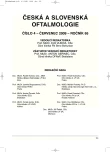Comparison of Contact and Immersion Techniques of Ultrasound Biometry in Terms of Target Postoperative Refraction
Authors:
J. Hřebcová; Š. Skorkovská; A. Vašků 1
Authors‘ workplace:
Klinika nemocí očních a optometrie FN u sv. Anny LF MU, Brno, přednosta doc. MUDr. S. Synek, CSc.
; Ústav patologické fyziologie LF MU, Brno, vedoucí prof. MUDr. A. Vašků, CSc.
1
Published in:
Čes. a slov. Oftal., 65, 2009, No. 4, p. 143-146
Overview
The success of cataract surgery in terms of the postoperative refractive result depends on the calculation of optimal intraocular lens (IOL) power. The accuracy of preoperative measurements (keratometry, biometry) is of a great importance due to the increasing patients’ demands on final refractive results. The purpose of this study was to compare the accuracy of contact and immersion techniques of A – scan ultrasound biometry in terms of target postoperative refraction while using the SRK/T formula. The accuracy of the applied biometric techniques was compared by means of the postoperative spherical equivalent (SE). The prospective longitudinal study included 111 non-paired eyes, and the preoperative biometry was performed by means of an OcuScan ultrasound machine (Alcon). The contact technique was used in 48 eyes whereas the immersion technique was employed in 63 eyes. The mean SE in the group measured by the contact technique was -0.13 D, compared to 0.25 D in the group with the applied immersion technique. No statistically significant difference was found in postoperative spherical equivalents while using both biometric techniques (p > 0.1). In this study the choice of a biometric technique had therefore no influence on the predicted postoperative refraction. The results have indicated that the biometric techniques (contact and immersion) are interchangeable in terms of postoperative refractive results.
Key words:
ultrasound biometry, eye axial length, contact technique, immersion technique, spherical equivalent
Sources
1. Hill W.E.: Axial Length: Do you measure up?, http://www.ophtahlmology management.com (issue 8/2002).
2. Hoffer K.J.: Intraocular lens calculation: The problem of short eye. Ophthalmic Surg., 12, 1981: 269–272.
3. Hoffer K.J.: The Hoffer Q formula: A comparison of theoretic and regression formulas. J. Cataract Refract. Surg., 19, 1993: 700-712, Errata: 20, 1994: 627.
4. Hoffmann P.C., Hütz W.W., Eckhardt H.B., Heuring A.H.: IOL – Berechnung und Ultraschallbiometrie: Immersions- und Kontaktverfahren. Klin. Monatsbl. Augenheilkunde, 213, 1998: 161–165.
5. Holladay J.T., Prager T.C., Ruiz R.S., Lewis J.W., et al: Improving the predictability of intraocular lens power calculations. Arch. Ophthalmol., 104, 1986: 539–541.
6. Hřebcová J., Vašků A.: Srovnání kontaktní a imerzní ultrazvukové biometrie. Čes. a slov. Oftal., 64, 2008, 1: 16–18.
7. Lai P.C., Savage H.L., Payman A.S.: Refractive surprise after contact ultrasonography (RESCU), Investigative Ophthalmology and Visual Science, 44, 2003: E - Abstract 212
8. Packer M., Fine I.H., Hoffman R.S.: Refractive Lens Surgery, USA, Springer, 2005: 243
9. Prager T.C., Hardten D.R., Fogal B.J.: Enhancing intraocular lens outcome precision: An evaluation of Axial Length determinations, keratometry, and IOL fomulas. Ophthalmol. Clin. N Am. 19, 2006: 435–448
10. Sanders D.R., Retzlaff J.A., Kraff M.C.: A-scan biometry and IOL implant power calculations. American Academy of Ophthalmology, Focal Points – Clin. Mod. Ophthalmol., 13, 1995, 10, 14.
11. Schelenz J., Kammann J.: Comparison of contact and immersion techniques for axial length measurement and implant power calculation. J. Cataract. Refract. Surg., 15, 1989: 425–428.
12. Shammas H.J.: A comparison of immersion and contact techniques for axial length measurement. Am. Intra-Ocular Implant Soc. J., 10, 1984: 444–447.
13. Watson A., Armstrong R.: Contact or immersion technique for axial length measurement? Australian and New Zealand J. Ophthalmol., 27, 1999: 49–51.
Labels
OphthalmologyArticle was published in
Czech and Slovak Ophthalmology

2009 Issue 4
Most read in this issue
- Retinal and Macular Changes after Surgical Treatment of Retinal Detachment
- Malignant Masquerade Syndromes
- Oclusion of Upper Ophthalmic Vein – a Case Report
- Endophtalmitis after Injury with Intraocular Foreign Body in Posterior Segment of the Eye
